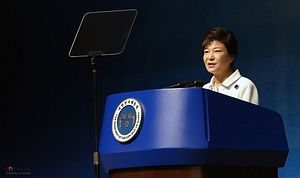Two months ago, it looked as though South Korea’s ruling conservative Saenuri Party would waltz through the upcoming local elections on June 4. Local elections in South Korea are often regarded as a reflection of presidential approval. As such, expectations of good results for the Saenuri Party were buoyed by polls in February and March that showed the incumbent president Park Geun-hye (twice-leader of the Saenuri Party during her days in the National Assembly) enjoying an approval rating just around 60 percent.
The discovery of the North Korean drones in late March and early April further bolstered public support for the conservatives. The South Korean public has traditionally viewed the Saenuri Party as more security-oriented than its liberal counterparts.
However, the sinking of the ferry Sewol on April 16 quickly shifted the national attention away from security to public safety and dealt a serious blow to the ruling party. The mishandling of the rescue operation and the perception that the president and members of her party had been insensitive to the grieving families of the victims became the catalyst for the massive loss of public confidence in both the president and her party. Polls revealed that support for Park, which stood at 61 percent in the first week of April, had collapsed to 46 percent by the first week of May.
This rapid decline in Park’s approval rating was immediately reflected in the country’s most important constituency, Seoul. Given that Park’s predecessor, President Lee Myung-bak, had been mayor of Seoul before seeking the country’s highest executive office, the mayoral election in the capital is a critical battleground for both parties in this election.
Prior to the ferry disaster, the Korean Broadcasting Service (KBS) had conducted a survey which showed Saenuri Party’s candidate for Seoul’s mayoral election, Chung Mong-joon, leading with 47.4 percent against the incumbent mayor Park Won-soon, who retained only 45.7 percent support in the city. Following the accident, the Gallup Korea poll on May 5 showed that Chung’s support had dropped to 39.2 percent while Park’s figures remained at 45.6 percent. Subsequently, the KBS report on May 20 revealed that Chung’s approval rating had slid further to 35.4 percent while support for Park had jumped to 51 percent. Similar boosts for liberal candidates were evident in the Incheon mayoral election and the gubernatorial race in Gyeonggi Province.
The public’s loss of confidence in the ruling party was also most evident among voters in their 40s. While the majority of younger Koreans in their 20s and 30s tended to vote for liberal parties, older voters traditionally viewed the conservatives more favorably. However, with the current government’s competency was called into question over the ferry disaster, approval for President Park among voters in their 40s fell from 61 percent to 38 percent. This bridging of the generation gap will no doubt play a critical role in the upcoming election.
All this sounds like a boon for South Korea’s struggling liberal opposition party, but the public outrage toward Park and the Saenuri Party has not translated into a national increase in support for the coalition of progressive-liberal politicians under the New Politics Alliance for Democracy (NPAD) Party. Having only been established in March of this year, the internally divided NPAD has been unable to prove that it would be more competent than the Saenuri Party in government. Therefore, the increased support for individual NPAD candidates in Seoul, Incheon and Gyeonggi Province appears largely derived from the public’s desire to punish the Saenuri Party, not necessarily from an increased confidence in the liberal party’s ability to govern. Therefore, neither parties are sitting comfortably.
The rapid reversal in Park and the Saenuri Party’s approval ratings in the face of the Sewol disaster reveals the highly volatile nature of public opinion in South Korea. Thus, while the Saenuri Party will certainly win fewer gubernatorial and mayoral seats than it had expected at the beginning of the year, this election will not determine how the public will vote two years from now in the 2016 parliamentary elections. This leaves room for both parties to make major adjustments in policy and posture in the months following the local election.
After all, if the last two months are any guide, a lot can happen in two years.

































